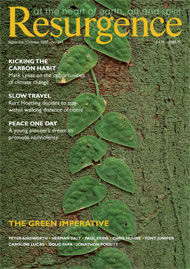IN THE EARLY part of the 20th century, Viktor Schauberger, a pioneering Austrian forester and brilliant inventor, paved the way for much of our modern understanding of the vital energies of water and the energy generation available from vortex mechanics.
The author of this book, Jane Cobbald, has herself experimented with another of Schauberger’s ideas: the use of copper implements for cultivation and planting. After experiencing a difference using copper tools in the garden, she became a student of his life’s work. Her illuminating and accessible book describes Schauberger’s observations and experiences in the forest, at lakes and rivers, which fostered his unique understanding of the nature of water: “The water’s most deeply concealed psyche often revealed the most extraordinary things to me.”
One such encounter was during a hot summer sitting by the Od Lake in upper Austria. “A very tall water spout rose from the centre of the lake.” The experience would in time reveal Schauberger’s insights into implosion. A pivotal principle governing the formation of all organic creation is the hollowing-out of inner space. This original motion is the inward curving suctional motion which follows a spiralling, pulsating rhythm, forming a vortex. It is the cool, condensing, levitating movement of implosion.
Applying his guiding motto – comprehend and copy – Schauberger developed the life-generating vortex-implosion principle into numerous patents and inventions. The technology of the Industrial Revolution (still used today) was based on inefficient, unnatural systems of energy and motion – motion Nature uses to decompose and dissolve matter. Most of the energy is lost during an explosive process through frictional resistance, producing useless waste heat. Implosion is regenerating and explosion is degenerating. “Today’s technology strives to move forwards with forces that operate backwards,” said Schauberger.
The chapter Cobbald entitled ‘Feeling the Earth’s Pulse’ discusses water’s temperature gradients – its rhythms of warming and cooling as it diffuses into the earth. This is an essential element in Schauberger’s view, as it relates to the stable temperature found in high mountain springs, a river’s ability to regulate itself, the soil’s absorption of rainwater, and reducing the damage to walls of dams.
Water reaches its greatest density at 4°C, just above freezing, and grows lighter as it solidifies and freezes – solid ice floats. Schauberger referred to this as the ‘anomaly point’. The sun warms bare, exposed soil, which becomes warmer than the falling rain. The groundwater expands more quickly than the rain, creating a negative temperature gradient from the earth to the air. Therefore, the rain is not able to be absorbed into the ground and runs off the surface. When trees and plants cover and protect the soil from overheating, it stays cooler, and a positive temperature gradient is created. The warmer rain expands into the soil where it is cooled and more rain can penetrate. Thus rainwater can go through a complete cycle assimilating through the earth, maturing and appearing at springs. Schauberger applied the anomaly point factor to several inventions including a mechanism which lessens temperature extremes in walls of dams.
Schauberger, through intuitive sensing and exploration into the intensive dimensions and living intelligence of Nature, has produced a cumulative body of wise and practical initiatives containing life-affirming, regenerative solutions for the malaise facing our culture and the Earth.








